NDVI stands for "Normalized Difference Vegetation Index". NRG stands for "Near-infrared / Red / Green". NDVI and NRG are both ways to visualize the amounts of infrared and other wavelengths of light reflected from vegetation. Because both these methods compare ratios of blue and red light absorbed versus green and IR light reflected, they can be used to evaluate the health of vegetation. It's a snapshot of how much photosynthesis is happening. This is helpful in assessing vegetative health or stress. (Read more here: https://www.agronomy.org/publications/jeq/articles/36/3/832) ## Do-It-Yourself These techniques for vegetation analysis were developed for satellite imagery, but at Public Lab, we've been working a lot on capturing infrared imagery using our DIY [near-infrared camera](/wiki/near-infrared-camera) setup, and combining it with visible bands to produce NDVI images such as the one above. ## What these images mean What exactly are these images we're trying to make? What do they tell us about vegetation, and why? These diagrams should help to understand what it is we're doing and why these are good ways to analyze plant life. ## The NDVI equation [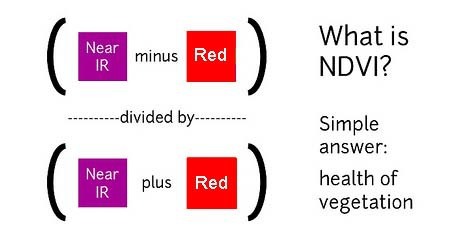](/i/44723) **NDVI = (Near Infrared - Red)/(Near Infrared + Red)** NDVI is a ratio which tries to emphasize photosynthesis while filtering out sun glare. The above equation is run for every pixel, using source data from an infrared photo and a visible light photo, like this pair: [](https://publiclab.org/system/images/photos/000/021/771/original/5390895115_c9d4d38fec_o.jpg) The result can be false-colored to make the high-photosynthesis areas more clear, and used to examine where plants are and how healthy they are. [](https://publiclab.org/system/images/photos/000/021/770/original/PetVISNDVIcomp.png) _Figure above: Normal color photo (right) and normalized difference vegetation index (NDVI) image (left). NDVI image was derived from two color channels in a single photo taken with a camera modified with a special infrared filter. Note that tree trunks, brown grass, and rocks have very low NDVI values because they are not photosynthetic. Healthy plants typically have NDVI values between 0.1 and 0.9. -- @cfastie_ ### Activities Here are a range of activities you can do to produce and interpret your own NDVI imagery, whether downloaded from a satellite imagery provider or [collected yourself using a DIY technique](/wiki/multispectral-imaging) [activities:ndvi] ****   Most DIY converted cameras today (those from Public Lab) use RGN instead of NRG, so the blue channel represents infrared instead of the red channel. That looks like this: [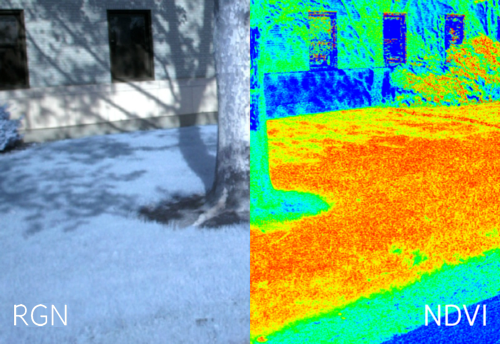](/i/45468?s=o) **** ## NRG imagery Some people are also interested in producing NRG imagery (like the below image), where `Near-Infrared, Red, and Green` are used to compose a picture instead of the usual `Red, Green, and Blue`. [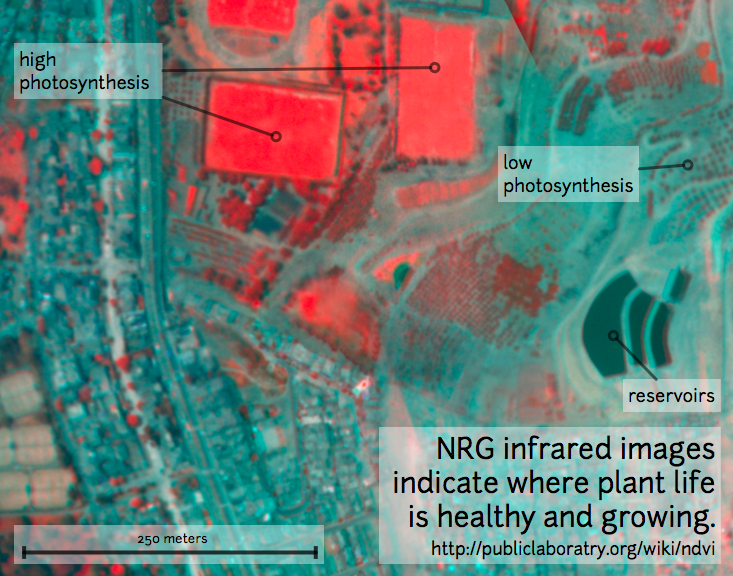](/i/25064) This diagram explains the swapping, which allows us to 'see' infrared as if it were a normal color: [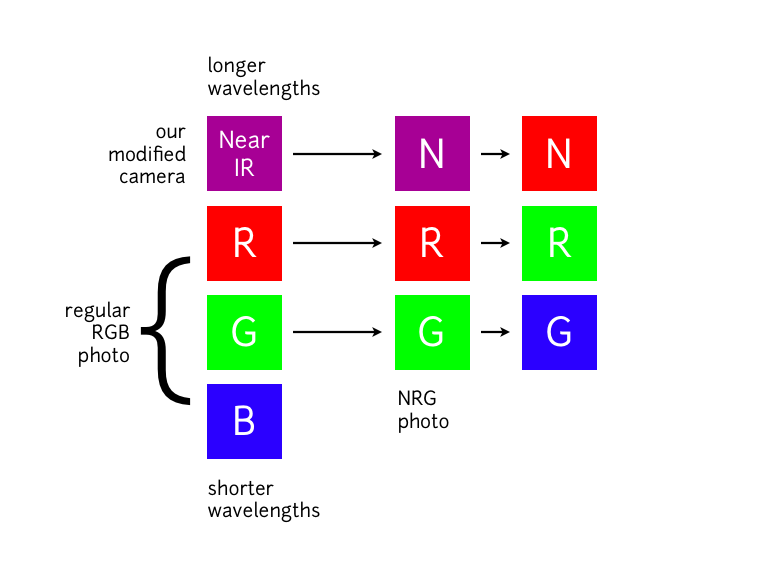](/i/25063) **In NRG images, the deeper and clearer the red color, the denser and healthier the vegetation (more or less).** ### Questions [questions:ndvi] ### Other examples of DIY NDVI imaging From around the internet: Begin watching at 2 minutes to see the resulting imagery: *This topic is part of the [Grassroots Mapping Curriculum](/wiki/mapping-curriculum) series.* **** [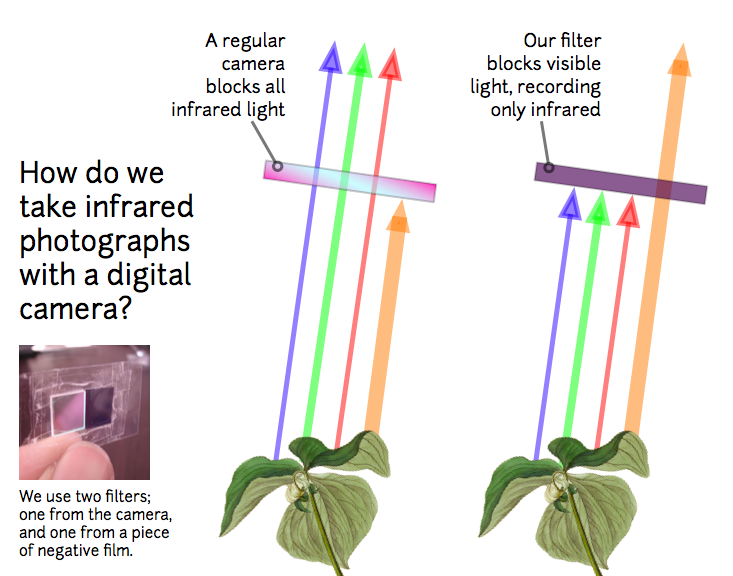](/i/25066) [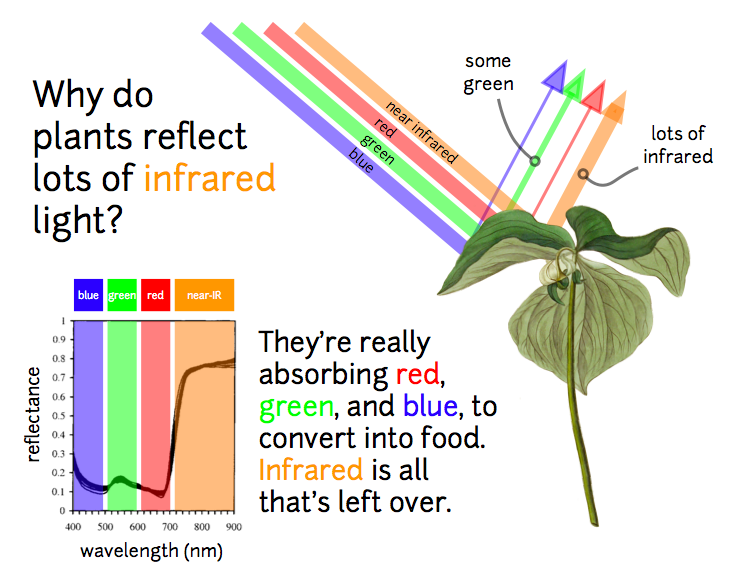](/i/25065) ...
| Author | Comment | Last activity | Moderation | ||
|---|---|---|---|---|---|
| mathew | "sorry, I was confused. clearly dual camera. " | Read more » | about 11 years ago | |||
| cfastie | "Mathew, To make sure there is no confusion, the (NIR-Red)/(NIR+Red) formula is not used for the BG3 filter because there is no red visible channel...." | Read more » | about 11 years ago | |||
| nedhorning | "Is this your conclusion or do we have to test lots of other materials that commonly show up in the NDVI images we take? I have looked at a lot of..." | Read more » | about 11 years ago | |||
| nedhorning | "Chris, So many questions... I think more testing is necessary but I'll take a shot at answering each question. I'd like to hear what other folks th..." | Read more » | about 11 years ago | |||
| cfastie | "Ned, The NDVI image made from the Rosco 2008 photo by stretching the histograms is surprisingly similar to your calibrated NDVI image from the red ..." | Read more » | about 11 years ago | |||
| cfastie | "Ned, this is good evidence that some materials, like grass clippings and pine boards, will be more easily distinguished from live green plants in N..." | Read more » | about 11 years ago | |||
| nedhorning | "If you use a dual-camera setup I suggest using an unmodified camera and a NIR-pass (visible cutoff) filter for the other camera. Some people use un..." | Read more » | about 11 years ago | |||
| Thorsten | "Ned, thanks! Confusion is good in most cases! :-) I think I'll give it a try and report. For such a setup do you propose the filters you used (bl..." | Read more » | about 11 years ago | |||
| cfastie | "This is really good information. Another thing that might make red filters a good choice is that it is easier to make a red filter than an infrablu..." | Read more » | about 11 years ago | |||
| nedhorning | "Hi Thorsten, Sorry for the confusion. Some of the non-linearity between the response of the red and blue filter should be explained in the post I d..." | Read more » | about 11 years ago | |||
| Thorsten | "Dear Ned et al., I am pretty new to all this and on my way to convert my camera for NDVI mapping. After reading this post I am little confused: bl..." | Read more » | about 11 years ago | |||
| mathew | "You and Ned are doing a great job of fleshing out this red vs. blue NDVI issue. thanks. its interesting to me that you can get such clear results..." | Read more » | about 11 years ago | |||
| mathew | "I love these, Chris. makes me want to process some of my passenger-pigeon shots. " | Read more » | about 11 years ago | |||
| mathew | "This is great, Ned-- thanks for illustrating it with your examples. The stark difference between NDVI of dead grass in the red channel is a pretty..." | Read more » | about 11 years ago | |||
| warren | "Amazing! You should rectify the concentrator photo and contact them... i bet they don't have as up to date an image as you took! " | Read more » | about 11 years ago | |||
| nedhorning | "One drawback of using the red filter is that the red part of the bayer filter passes more NIR than the blue or green parts. I'm looking into ways t..." | Read more » | about 11 years ago | |||
| patcoyle | "Interesting work. Thanks Ned. " | Read more » | about 11 years ago | |||
| warren | "Wow, this is an exciting development. I had wondered about using red instead of blue, but your results are compelling. I also wonder if this would ..." | Read more » | about 11 years ago | |||
| funkycbj | "You want to capture enough spectral variation between different surface features. If you only have 2 bands but have several classes then you may ge..." | Read more » | about 11 years ago | |||
| nedhorning | "I'm curious why you need at least 3 bands for automated classification. I don't have a specific classification task in mind. In general I'm working..." | Read more » | about 11 years ago | |||
| funkycbj | "If you take pictures at higher angles (more perpendicular and less oblique) you may achieve a more Lambertian response. Dealing more directly with ..." | Read more » | about 11 years ago | |||
| nedhorning | "That's a good observation. The hotspot in these test images would tend to be toward the bottom around the shadow from Chris' head since that's wher..." | Read more » | about 11 years ago | |||
| funkycbj | "I noticed that you are capturing your test images from an oblique angle. Bidirectional reflectance at that angle may be creating "hot spots" in you..." | Read more » | about 11 years ago | |||
| nedhorning | "If it's sunny tomorrow I'll be out with the wood, tar paper and other things. With a little luck I'll have a research note before the end of the we..." | Read more » | about 11 years ago |